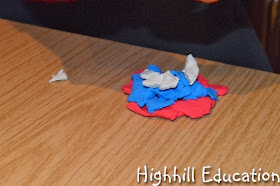Geology Unit Study
Week 5: We used crayons Crayola Model MagicRocks are scientific clues which help us decode the mystery of landforms. They can tell stories about past volcanic activity and whether a landscape was once covered with water. Some rocks are typically found alongside other rocks and knowing which are found together can lead to new discoveries underground.
There are three types of rocks: igneous, metamorphic and sedimentary. Through heat, pressure and erosion, each type of rock can be changed into the other two. Last year Lucinda at Navigating by Joy put together a fabulous rock cycle unit study. Her post contains several links to videos and additional resources we found very useful. Our favorite portion of her post was by far simulating the rock cycle with crayon. We repeated her rock cycle experiment with crayon and then got even better results using Crayola Model Magic.
Rock Cycle Simulated with Crayola Model Magic
First small pieces of red, white and blue were created to represent erosion.
The colors were placed in layers as this is the way sediments typically build on land.
Next pressure was added to create a sedimentary rock.
Sedimentary Rock - Notice how the layers are distinct.
Next pressure was added to create metamorphic rock.
Often multiple types of sediment are visible within metamorphic rock.
Metamorphic Rock after it has undergone additional pressure.
Next the metamorphic rock was wrapped in aluminum foil and submerged in hot water. The heat worked to change the rock into igneous rock.
After the first application of heat, striations were still visible in the rock. Therefore, it was still in the metamorphic state.
After several more heat and pressure cycles the metamorphic rock was completely changed into igneous rock.
To see the rest of the projects of our Earth Science Unit please visit our Science Page.
For activity ideas from others visit these blog hops.













No comments:
Post a Comment
Note: Only a member of this blog may post a comment.